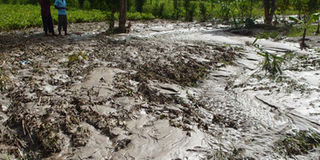Prime
Insuring your crops and livestock to avoid losses

Farmers can now get insured against losses caused by adverse weather conditions. PHOTO BY ABDULAZIIZI TUMUSIIME
What you need to know:
When your livelihood depends on farming, you know what it means to be at the mercy of nature. So it is prudent to seek protection against the risks and minimise the losses.
Since time immemorial, farmers have always devise means to limit risks through measures like crop rotation, diversification and intercropping but residual risks still remain.
Every year, thousands of acres of farmlands are destroyed by natural calamities. Output is mainly affected by weather conditions such as drought, floods, strong winds or hailstorms, which in many cases are unpredictable in frequency of occurrence and severity. This is in addition to risks of being wiped out by diseases and pests or even fires, which can erupt during dry seasons.
In May, Kasese, mainly, and neighbouring districts were hit by floods and about 1,000 acres covered by crops were destroyed. It may be hard for the farmers to recover quickly as they may not be able to clear their gardens to resume farming. Such incidents can happen to any farmer and they definitely affect production.
Agriculture has always been a risky business and thus to protect against adverse weather and other vagaries, it is now possible in Uganda to have insurance to provide agricultural risk management.
When it comes to agricultural insurance, a farmer wants to understand how much it will cost, and how damages and losses will be assessed. A pay out does not restore the farm but covers the financial losses incurred.
The farmer will be protected by way of indemnification. Rainfall will be measured at the nearest weather station and by use of satellite remote sensing tools.
But how will it work?
The coverage starts at the beginning of the rainy season, when rainfall is deemed adequate and ends at harvest. If there is a shortfall during any part of the growing period, the farmer will receive a payout to offset against the outstanding pre-determined production cost.
For example, if you expect 100 bags of maize from your five acres and, because of drought, you yield 60 bags, the insurance company will pay out on the loss of 40 bags. Claims are paid at harvest time because that is when you can tell the total yield.
To get this insurance, farmers will have to be part of an association or have no less than five acres. For the start, the product will provide cover for crops like maize, beans and cattle. For livestock, the animals should be kept on one farm with 50 being the minimum number. It will cover an animal within a specified geographical area from death caused by fire, lighting, flood, rainstorm, windstorm, drought, earthquake, diseases and surgical operations. This should be within the insured period.
Payments are made equal to financial loss caused by the death of the insured animal (not exceeding the sum insured or its market value at the time of loss). The animals that can be insured must be six months to seven years old.
Costing
As mentioned earlier, at the beginning of each season, the farmer takes out a policy with sum insured as the value of expected revenue from anticipated harvest at the end of the season. Premium or payments are calculated using the value of the crops and livestock at the time of insurance. For example, if the value of the calf at six months is Shs300,000, the cover will be the value of the cow at the time of the loss. This means that if the cow dies after three years and its value is Shs1m, the insurance company will pay Shs1m.
The premium rating stands at two to five per cent of the sum insured. A farmer who insured crops at Shs10m will pay Shs200,000-Shs500,000. So, the farmer pays the premium which is non-refundable.
Agricultural insurance is a new area of business, which calls for information and knowledge in various aspects to be built up. The Insurance Regulatory Authority of Uganda (IRA) encourages the service providers to engage in continuous sensitisation and training to enhance awareness.
This will help eliminate the fear of the unknown and unfamiliar that surrounds insurance business. Further still, creation of a data bank should also be considered where information about developed models, difficulties encountered and experiences gained will be stored for future reference.
The writer is the Communications Officer, IRA.
E-mail: [email protected]




